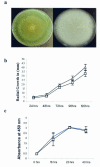Aspergillus fumigatus variant with decreased susceptibility to multiple antifungals
- PMID: 15047520
- PMCID: PMC375298
- DOI: 10.1128/AAC.48.4.1197-1203.2004
Aspergillus fumigatus variant with decreased susceptibility to multiple antifungals
Abstract
Isolates of Aspergillus fumigatus that demonstrate resistance to itraconazole (ITZ) have been described previously; however, the prevalence and clinical significance of ITZ resistance are not completely understood. In this study we assessed the ITZ susceptibilities of 128 A. fumigatus isolates that caused invasive infection in 82 stem cell transplant patients before and after the use of ITZ in our institution (study period, 1991 to 2000). The MICs for 10 isolates obtained from seven patients were high, > or 1 microg/ml. The average ITZ MIC increased after institutional use of the drug began in 1995. The majority of the isolates for which MICs were high (6 of 10) and one isolate for which the MIC was low (0.06 microg/ml) demonstrated an unusual phenotype, appearing as predominantly white colonies. For all seven atypical isolates, voriconazole MICs were high (> or = 2 microg/ml), and minimal effective concentrations of caspofungin were high (> or 4 microg/ml). For two of the seven atypical isolates, amphotericin B MICs were high (> or 2 microg/ml). The isolates appeared white due to slow sporulation; however, after prolonged incubations, the isolates sporulated with no difference in conidial color or conidiophore morphology compared with typical isolates. Randomly amplified polymorphic DNA-PCR patterns of these isolates were distinct compared with those of other A. fumigatus isolates. Sequencing of 18S rRNA genes confirmed that all were A. fumigatus; however, the mitochondrial cytochrome b gene sequences of all the atypical isolates were unique. These data suggest the potential presence of a genetically unique, poorly sporulating variant of A. fumigatus that demonstrates decreased susceptibilities to several antifungals.
Figures



References
-
- Chandrasekar, P. H., J. L. Cutright, and E. K. Manavathu. 2001. Aspergillus: rising frequency of clinical isolation and continued susceptibility to antifungal agents, 1994-1999. Diagn. Microbiol. Infect. Dis. 41:211-214. - PubMed
-
- Dannaoui, E., E. Borel, M. F. Monier, M. A. Piens, S. Picot, and F. Persat. 2001. Acquired itraconazole resistance in Aspergillus fumigatus. J. Antimicrob. Chemother. 47:333-340. - PubMed
-
- Denning, D. W., S. A. Radford, K. L. Oakley, L. Hall, E. M. Johnson, and D. W. Warnock. 1997. Correlation between in-vitro susceptibility testing to itraconazole and in-vivo outcome of Aspergillus fumigatus infection. J. Antimicrob. Chemother. 40:401-414. - PubMed
Publication types
MeSH terms
Substances
Grants and funding
LinkOut - more resources
Full Text Sources

